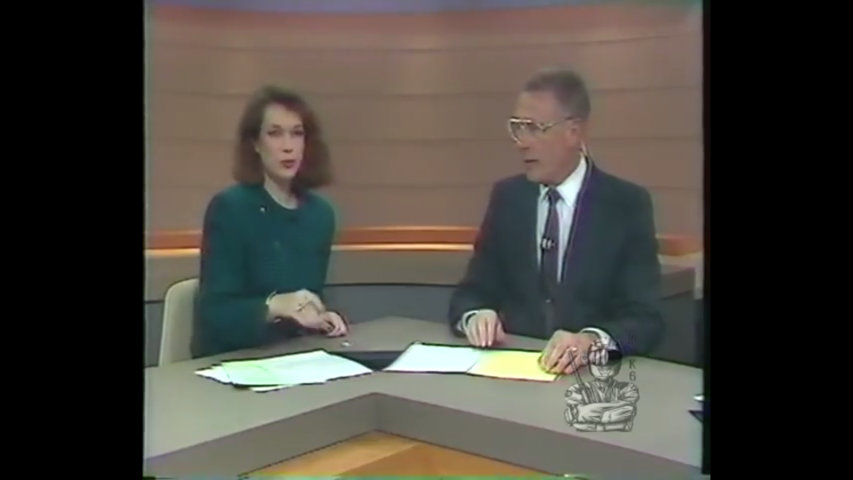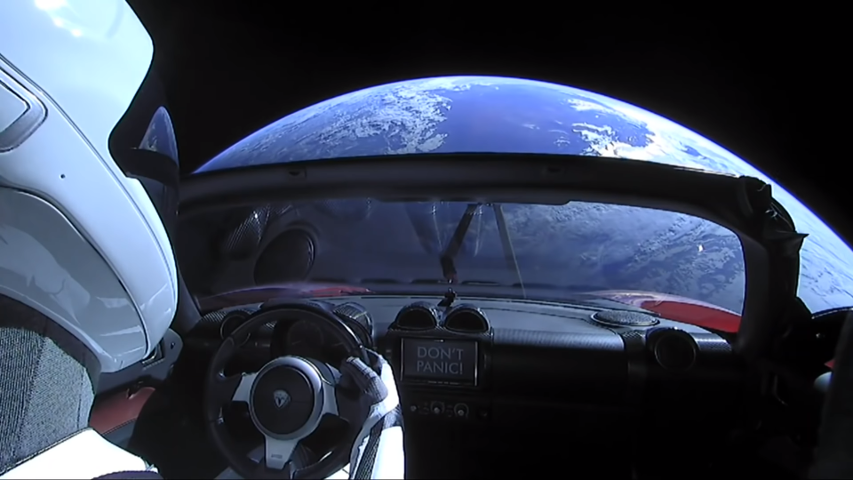Longer sentence that doesn't fit the title: Is there a term for how most video and some photography tends to outline bright sources of light (on dark scenery) with a dark or even black border? In extreme cases it is even possible to identify brighter borders contouring the artificial black borders.
This is something that has bugged me for decades. I have generally associated the phenomenon with standard-definition analog recordings -- any TV programming that was recorded at 480i, and of course any home videos. It gives such video a cheap look that one does not see, for example, in filmed content, even after those films are moved to analog video.
An example from the early 90s:
Bright areas like the folders on the desk are very sharply contoured with black borders that were definitely not there in real life. Most curious and frustrating of all is that the black afforded those contours is the blackest black in the video -- very often even blacker than anything else, including things that were actually black before they were recorded! Take a look at the dark gap in the middle of the desk. One would expect that area to be the purest black, but in terms of darkness it's actually defeated by the black contours next to it.
But as I said, this phenomenon plagues anything recorded at 480i. I've never seen an NTSC video camera that didn't do this. Here is a specimen from the recent Falcon Heavy launch, whose video cameras were 480i:
Every single area in this image which approaches pure white has its very own black contour.
Photography doesn't seem to be completely free of this phenomenon. I'll reference this photo:
http://cdn.digital-photo-secrets.com/images/night-road-city-traffic-jam.jpg
The contouring is much less pronounced than what you get with analog video, which prevents it from having that cheap look. But really, almost every single major contrast -- between lights and the surrounding dark -- has contours. Black contours on the outside, and white contours on the inside.
Film, especially for movies, does not seem to suffer from the same phenomenon.
Now, I am not oblivious to why one might wish to deliberately engineer this contouring trick into imaging hardware. I get it. What I'm after here is some answers to some questions about the phenomenon. These are newbie questions, of course.
1: What is this called? "False contouring" already covers a different phenomenon related to low-quality digital images and video.
2: Is it actually fully intended, especially in the case of older analog recording hardware and standards, or is it the result of some shortcoming of the hardware?
3: Why is it so prevalent, even today in 2019 when artificial things like this, which are a failure to match what the eyes actually see, aren't needed on our screens which boast 4K+ resolution?
4: Has anyone ever developed a video (or image) filter which attempts to correct for these particular artificial contours? Are there examples?
+ Reply to Thread
Results 1 to 5 of 5
-
-
I think what you see is ringing, caused by the HQ ("High Quality") circuitry added to second generation (and beyond) VCRs. It is basically a small capacitor that causes overshoot (a.k.a., peaking) at sharp light/dark transitions. It was added because VCRs degraded the already-unsharp NTSC (and PAL) video to the point that even on the small CRT screens of that era, the video looked pretty fuzzy. This circuit gave the illusion of more detail.
The solution, if you don't want it, is to turn off this circuit. Most better VCRs have a switch that will turn it off. You always want to turn off this circuit when capturing video. On many VCRs the switch (or menu item) is called "Edit" because the designers figured that the only time you'd want to turn it off was when copying a tape. -
They are oversharpening halos. The sharpening filters are used to make inherently blurry sources look sharper. VHS is the worst offender. Debayering of camera sensors can also cause it (all camera manufactures lie about the true resolution of their sensors). People who don't know what they're doing often cause or exacerbate it by using resizing filters that sharpen. They can also be caused by video compression -- DCT ringing.
https://en.wikipedia.org/wiki/Ringing_artifactsLast edited by jagabo; 15th Mar 2019 at 06:45.
-
"Ringing" does seem to be the answer.
Any guesses as to why even the very latest 480i cameras (Falcon Heavy image) still exhibit the problem? The detail that can be discerned in that image is higher than the size of the contours so it is not, I think, something that can be pinned on the camera's sensor. It seems like the camera is doing this by design. Quite needlessly, I feel. And it is because of this that I can't shake the sense that it's just something all analog cameras do. I have never seen otherwise. -
Debayering filters used on almost all cameras routinely sharpen the image to make up for the lie about the camera's true resolution.
https://en.wikipedia.org/wiki/Bayer_filter
The one exception I know of is Foveon who uses stacked transparent sensors rather than beyar sensors.
Similar Threads
-
Video looks way too dark
By killerteengohan in forum RestorationReplies: 21Last Post: 22nd Sep 2017, 07:43 -
dark video help
By amicrazyornot in forum EditingReplies: 21Last Post: 14th May 2015, 20:51 -
how would I color correct a video shot under halogen lights
By stoneystevenson in forum Newbie / General discussionsReplies: 3Last Post: 16th Jan 2015, 11:25 -
What is the proper term for this video defect?
By JeremyBrown in forum Newbie / General discussionsReplies: 3Last Post: 25th Dec 2014, 04:34 -
Has anybody here used LED flood lights for film/video?
By julitomg in forum Camcorders (DV/HDV/AVCHD/HD)Replies: 3Last Post: 6th Nov 2014, 11:10






 Quote
Quote